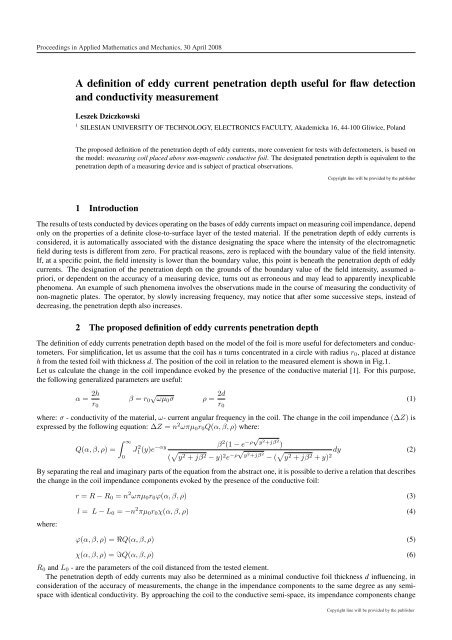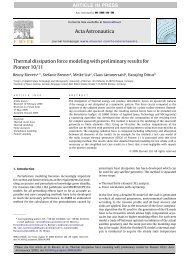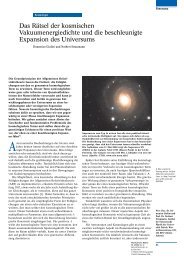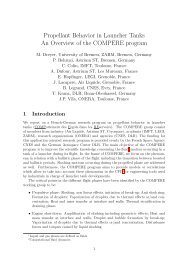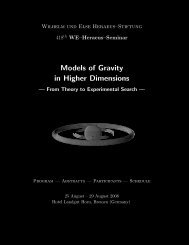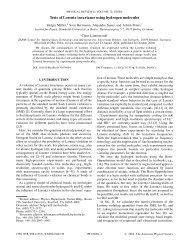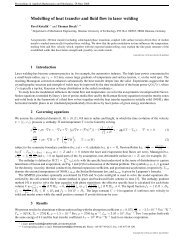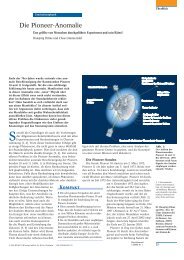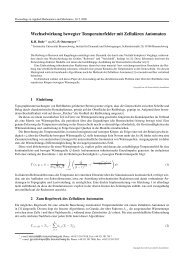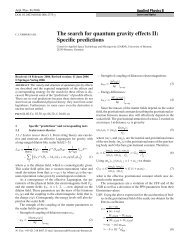A definition of eddy current penetration depth useful for flaw ... - ZARM
A definition of eddy current penetration depth useful for flaw ... - ZARM
A definition of eddy current penetration depth useful for flaw ... - ZARM
Create successful ePaper yourself
Turn your PDF publications into a flip-book with our unique Google optimized e-Paper software.
Proceedings in Applied Mathematics and Mechanics, 30 April 2008<br />
A <strong>definition</strong> <strong>of</strong> <strong>eddy</strong> <strong>current</strong> <strong>penetration</strong> <strong>depth</strong> <strong>useful</strong> <strong>for</strong> <strong>flaw</strong> detection<br />
and conductivity measurement<br />
Leszek Dziczkowski<br />
1 SILESIAN UNIVERSITY OF TECHNOLOGY, ELECTRONICS FACULTY, Akademicka 16, 44-100 Gliwice, Poland<br />
The proposed <strong>definition</strong> <strong>of</strong> the <strong>penetration</strong> <strong>depth</strong> <strong>of</strong> <strong>eddy</strong> <strong>current</strong>s, more convenient <strong>for</strong> tests with defectometers, is based on<br />
the model: measuring coil placed above non-magnetic conductive foil. The designated <strong>penetration</strong> <strong>depth</strong> is equivalent to the<br />
<strong>penetration</strong> <strong>depth</strong> <strong>of</strong> a measuring device and is subject <strong>of</strong> practical observations.<br />
Copyright line will be provided by the publisher<br />
1 Introduction<br />
The results <strong>of</strong> tests conducted by devices operating on the bases <strong>of</strong> <strong>eddy</strong> <strong>current</strong>s impact on measuring coil impendance, depend<br />
only on the properties <strong>of</strong> a definite close-to-surface layer <strong>of</strong> the tested material. If the <strong>penetration</strong> <strong>depth</strong> <strong>of</strong> <strong>eddy</strong> <strong>current</strong>s is<br />
considered, it is automatically associated with the distance designating the space where the intensity <strong>of</strong> the electromagnetic<br />
field during tests is different from zero. For practical reasons, zero is replaced with the boundary value <strong>of</strong> the field intensity.<br />
If, at a specific point, the field intensity is lower than the boundary value, this point is beneath the <strong>penetration</strong> <strong>depth</strong> <strong>of</strong> <strong>eddy</strong><br />
<strong>current</strong>s. The designation <strong>of</strong> the <strong>penetration</strong> <strong>depth</strong> on the grounds <strong>of</strong> the boundary value <strong>of</strong> the field intensity, assumed a-<br />
priori, or dependent on the accuracy <strong>of</strong> a measuring device, turns out as erroneous and may lead to apparently inexplicable<br />
phenomena. An example <strong>of</strong> such phenomena involves the observations made in the course <strong>of</strong> measuring the conductivity <strong>of</strong><br />
non-magnetic plates. The operator, by slowly increasing frequency, may notice that after some successive steps, instead <strong>of</strong><br />
decreasing, the <strong>penetration</strong> <strong>depth</strong> also increases.<br />
2 The proposed <strong>definition</strong> <strong>of</strong> <strong>eddy</strong> <strong>current</strong>s <strong>penetration</strong> <strong>depth</strong><br />
The <strong>definition</strong> <strong>of</strong> <strong>eddy</strong> <strong>current</strong>s <strong>penetration</strong> <strong>depth</strong> based on the model <strong>of</strong> the foil is more <strong>useful</strong> <strong>for</strong> defectometers and conductometers.<br />
For simplification, let us assume that the coil has n turns concentrated in a circle with radius r 0 , placed at distance<br />
h from the tested foil with thickness d. The position <strong>of</strong> the coil in relation to the measured element is shown in Fig.1.<br />
Let us calculate the change in the coil impendance evoked by the presence <strong>of</strong> the conductive material [1]. For this purpose,<br />
the following generalized parameters are <strong>useful</strong>:<br />
α = 2h<br />
r 0<br />
β = r 0<br />
√ ωµ0 σ ρ = 2d<br />
r 0<br />
(1)<br />
where: σ - conductivity <strong>of</strong> the material, ω- <strong>current</strong> angular frequency in the coil. The change in the coil impendance (∆Z) is<br />
expressed by the following equation: ∆Z = n 2 ωπµ 0 r 0 Q(α, β, ρ) where:<br />
Q(α, β, ρ) =<br />
∫ ∞<br />
0<br />
J 2 1 (y)e −αy β 2 (1 − e −ρ√ y 2 +jβ 2 )<br />
( √ y 2 + jβ 2 − y) 2 e −ρ√ y 2 +jβ 2 − ( √ y 2 + jβ 2 + y) 2 dy (2)<br />
By separating the real and imaginary parts <strong>of</strong> the equation from the abstract one, it is possible to derive a relation that describes<br />
the change in the coil impendance components evoked by the presence <strong>of</strong> the conductive foil:<br />
r = R − R 0 = n 2 ωπµ 0 r 0 ϕ(α, β, ρ) (3)<br />
where:<br />
l = L − L 0 = −n 2 πµ 0 r 0 χ(α, β, ρ) (4)<br />
ϕ(α, β, ρ) = RQ(α, β, ρ) (5)<br />
χ(α, β, ρ) = IQ(α, β, ρ) (6)<br />
R 0 and L 0 - are the parameters <strong>of</strong> the coil distanced from the tested element.<br />
The <strong>penetration</strong> <strong>depth</strong> <strong>of</strong> <strong>eddy</strong> <strong>current</strong>s may also be determined as a minimal conductive foil thickness d influencing, in<br />
consideration <strong>of</strong> the accuracy <strong>of</strong> measurements, the change in the impendance components to the same degree as any semispace<br />
with identical conductivity. By approaching the coil to the conductive semi-space, its impendance components change<br />
Copyright line will be provided by the publisher
PAMM header will be provided by the publisher 2<br />
Fig.1. The contact coil above the tested element Fig.2. Graphs <strong>of</strong> function a(α, β, ρ)<br />
by values: r and l. The <strong>penetration</strong> <strong>depth</strong> <strong>of</strong> <strong>eddy</strong> <strong>current</strong>s is regarded as equal to dp designated in the following way: after<br />
approaching an identical coil at the identical distance, not to the semi-space, but, this time, to the foil with thickness d p the<br />
coil impendance components changed by values r and l designated with the accuracy <strong>of</strong> the error in the measurement by a<br />
given measuring device. Let us denote the error in designating the resistance change as δr, and the coil inductivity as δl. For<br />
given generalized parameters α and β, each <strong>of</strong> the equations expressed below may be solved in view <strong>of</strong> unknown ρ.<br />
2 · δr<br />
n 2 ωπµ 0 r 0<br />
=<br />
∣ ∣∣∣ ∣ϕ(α, β, ρ) − lim ϕ(α, β, ρ) ⇒ ϕ r<br />
ρ→∞<br />
2 · δl<br />
n 2 πµ 0 r 0<br />
=<br />
∣ ∣∣∣ ∣χ(α, β, ρ) − lim χ(α, β, ρ) ⇒ ϕ l<br />
ρ→∞<br />
Let us assume that the maximal value from all the calculated values <strong>of</strong> ρ r and ρ l shall be the generalized <strong>penetration</strong> <strong>depth</strong><br />
<strong>of</strong> <strong>eddy</strong> <strong>current</strong>s: ρ p = MAX(ρ r , ρ l ). The real <strong>penetration</strong> <strong>depth</strong> may be derived if the dimensions <strong>of</strong> the contact coil are<br />
known: d p = (ρ p · r 0 )/2.<br />
3 Some properties <strong>of</strong> the proposed <strong>definition</strong> <strong>of</strong> <strong>eddy</strong> <strong>current</strong>s <strong>penetration</strong> <strong>depth</strong><br />
To illustrate the outcome <strong>of</strong> the proposed <strong>definition</strong> <strong>of</strong> <strong>eddy</strong> <strong>current</strong>s <strong>penetration</strong> <strong>depth</strong> some numerical calculations were<br />
made. In Fig.2 the values <strong>of</strong> function a(α, β, ρ) = n2 ωπµ 0 r 0<br />
2<br />
· [ϕ(α, β, ρ) − lim ρ→∞ ϕ(α, β, ρ)] were plotted, depending on<br />
parameter ρ <strong>for</strong> α=0,4 and <strong>for</strong> some values <strong>of</strong> β=3, 4, 5 i 6.<br />
To designate the <strong>penetration</strong> <strong>depth</strong> <strong>of</strong> <strong>eddy</strong> <strong>current</strong>s, the values <strong>of</strong> function a(α, β, ρ) should be compared with the error in the<br />
coil resistance measurement. The insensitivity zone <strong>of</strong> the measuring device was plotted in Fig.2.<br />
For generalized parameter β = 3, generalized <strong>penetration</strong> <strong>depth</strong> is ρ 3 . Likewise, if frequency is increased to the value<br />
<strong>of</strong> generalized parameter β = 4, the <strong>penetration</strong> <strong>depth</strong> <strong>of</strong> <strong>eddy</strong> <strong>current</strong>s shall decrease to the value corresponding to ρ 3 .<br />
Another increase in frequency corresponding to the value <strong>of</strong> generalized parameter β = 5 leads to improved sensitivity <strong>of</strong> the<br />
measuring method at higher <strong>depth</strong>s and, accordingly, to the <strong>penetration</strong> <strong>depth</strong> <strong>of</strong> <strong>eddy</strong> <strong>current</strong>s equal to ρ 5 which is bigger<br />
than ρ 4 . Every successive increase in frequency evokes a significant decrease in the <strong>penetration</strong> <strong>depth</strong> <strong>of</strong> <strong>eddy</strong> <strong>current</strong>s to the<br />
values <strong>of</strong> generalized parameter ρ 6 .<br />
4 Conclusions<br />
Changes in the frequency <strong>of</strong> the exciting field lead to changes in the <strong>penetration</strong> <strong>depth</strong> <strong>of</strong> <strong>eddy</strong> <strong>current</strong>s. The <strong>penetration</strong> <strong>depth</strong><br />
may be calculated by means <strong>of</strong> numerical methods on the grounds <strong>of</strong> the model: contact coil placed above semi-space. It<br />
turns out that the presence <strong>of</strong> a <strong>flaw</strong> in the tested material, even if located beneath the designated boundary, is detected by the<br />
measuring device. Such <strong>flaw</strong> apparently increases the <strong>penetration</strong> <strong>depth</strong> <strong>of</strong> <strong>eddy</strong> <strong>current</strong>s. Thus, the measuring device has a<br />
<strong>penetration</strong> zone bigger than the calculated <strong>eddy</strong> <strong>current</strong>s <strong>penetration</strong> <strong>depth</strong>. The proposed <strong>definition</strong>: measuring coil placed<br />
above conductive non-magnetic foil is more convenient <strong>for</strong> defectometers, as it is equivalent to the <strong>penetration</strong> <strong>depth</strong> <strong>of</strong> the<br />
measuring device. On the grounds <strong>of</strong> the described model, every advanced piece <strong>of</strong> equipment may be used <strong>for</strong> estimating and<br />
displaying the actual <strong>penetration</strong> <strong>depth</strong> <strong>of</strong> <strong>eddy</strong> <strong>current</strong>s, depending on the coil properties and frequency.<br />
References<br />
[1] L. Dziczkowski, M. Dziczkowska, A <strong>useful</strong> mathematical model <strong>for</strong> analysis <strong>of</strong> non-magnetic thin foil on the grounds <strong>of</strong> the <strong>eddy</strong><br />
<strong>current</strong> method. Mainostroenie i Technosfera XXI weka. Sprawnik Trudow XIV Medunarodnoj Naucno-techniceskoj Konferencji,<br />
Donieck-2007, T.5, p.26-31.<br />
[2] Dziczkowski L., The analysis <strong>of</strong> determining the conductance and thickness <strong>of</strong> thin non-magnetic foil by the <strong>eddy</strong> <strong>current</strong> method,<br />
Mainostroenie i Technosfera XXI weka. Sprawnik Trudow XIV Medunarodnoj Naucno-techniceskoj Konferencji, Donieck-2007, T.5,<br />
p.22-26.<br />
[3] Dziczkowski L., Errors in the simultaneous determination <strong>of</strong> conductivity and foil thickness by the <strong>eddy</strong> curent method based on a<br />
single measurement, Avtomatizacja: Problemy, Idei, Reenija, Materialy Medunarodnoj Naucno-techniceskoj Konferencji, Sevastopol-<br />
2007, p.137-140.<br />
Copyright line will be provided by the publisher


